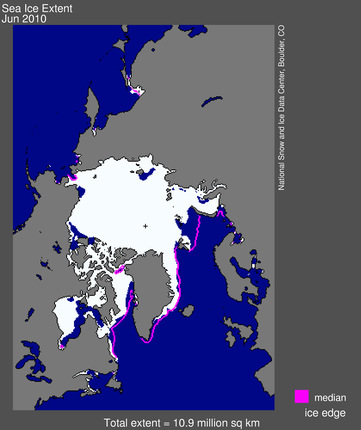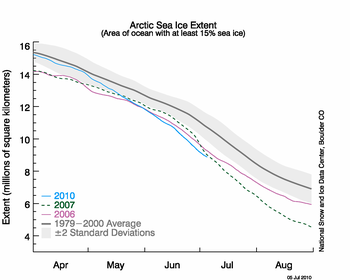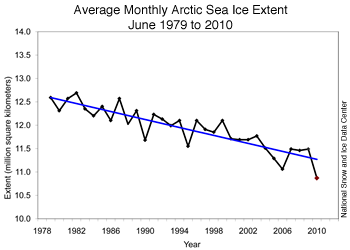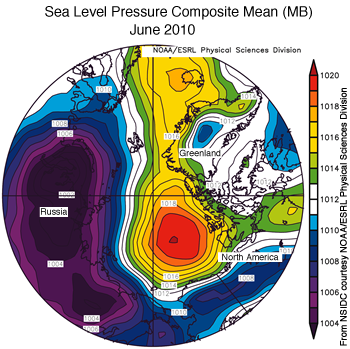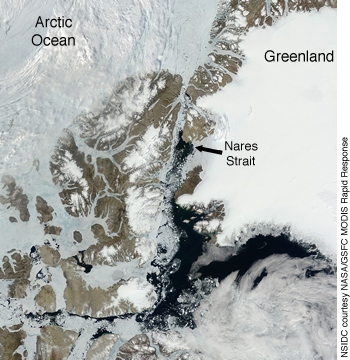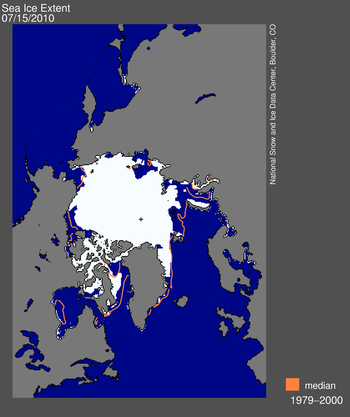 Figure 1. Daily Arctic sea ice extent on July 15 was 8.37 million square kilometers (3.23 million square miles). The orange line shows the 1979 to 2000 median extent for that day. The black cross indicates the geographic North Pole. Sea Ice Index data. About the data. —Credit: National Snow and Ice Data Center
Figure 1. Daily Arctic sea ice extent on July 15 was 8.37 million square kilometers (3.23 million square miles). The orange line shows the 1979 to 2000 median extent for that day. The black cross indicates the geographic North Pole. Sea Ice Index data. About the data. —Credit: National Snow and Ice Data CenterHigh-resolution image
Overview of conditions
From July 1 to 15, Arctic sea ice extent declined an average of 60,500 square kilometers (23,400 square miles) per day, 22,500 square kilometers (8,690 square miles) per day slower than the 1979 to 2000 average and substantially slower than the rate of decline in May and June.
Ice extent remained lower than normal in all regions of the Arctic, with open water developing along the coasts of northwest Canada, Alaska and Siberia.
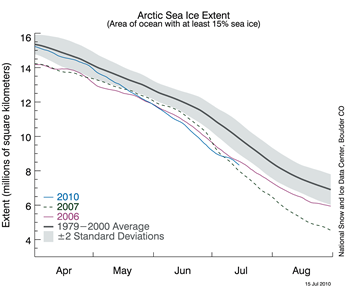 Figure 2. The graph above shows daily Arctic sea ice extent as of July 15, 2010. The solid light blue line indicates 2010; dashed green shows 2007; solid pink shows 2006, and solid gray indicates average extent from 1979 to 2000. The gray area around the average line shows the two standard deviation range of the data. Sea Ice Index data.—Credit: National Snow and Ice Data Center
Figure 2. The graph above shows daily Arctic sea ice extent as of July 15, 2010. The solid light blue line indicates 2010; dashed green shows 2007; solid pink shows 2006, and solid gray indicates average extent from 1979 to 2000. The gray area around the average line shows the two standard deviation range of the data. Sea Ice Index data.—Credit: National Snow and Ice Data CenterHigh-resolution image
Conditions in context
As of July 15, total extent was 8.37 million square kilometers (3.23 million square miles), which is 1.62 million square kilometers (625,000 square miles) below the 1979 to 2000 average for the same date, but 360,000 square kilometers (139,000 square miles) above July 15, 2007, the lowest extent for that date in the satellite record.
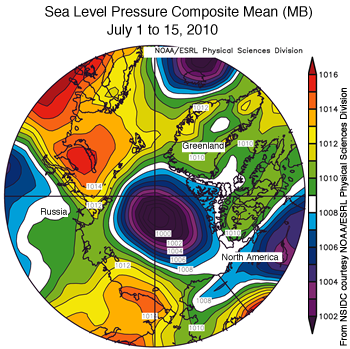
Figure 3. This map of sea level pressure for July 1 to 15, 2010 shows low pressure over the central Arctic Ocean, a pattern that brought cooler and cloudier conditions.—Credit: National Snow and Ice Data Center courtesy NOAA/ESRL Physical Sciences Division
High-resolution image
A change in circulation
Through much of May and June, high pressure dominated the Beaufort Sea with low pressure over Siberia. Winds associated with this pattern, known as the dipole anomaly, helped speed up ice loss by pushing ice away from the coast and promoting melt.
However, the dipole anomaly pattern broke down in early July. In the first half of July, cyclones (low pressure systems) generated over northern Eurasia tracked eastward along the Siberian coast and then into the central Arctic Ocean, where they tend to stall. This cyclone pattern is quite common in summer. The low-pressure cells have brought cooler and cloudier conditions over the Arctic Ocean. They have also promoted a cyclonic (anticlockwise) sea ice motion, which acts to spread the existing ice over a larger area. All of these factors likely contributed to the slower rate of ice loss over the past few weeks.
In the last few days, high pressure has started to build again in the Beaufort Sea, but whether this will continue remains to be seen.
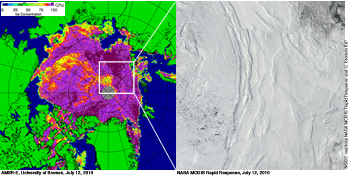
Figure 4. In mid-summer, the NASA Advanced Microwave Scanning Radiometer – Earth Observing System (AMSR-E) (left) may show areas of low ice concentration which are actually melt ponds or weather effects. Visible band images from the NASA Moderate Resolution Imaging Spectroradiometer (right) confirm areas of low-concentration sea ice in the interior pack ice. Both images are from July 12, 2010.—Credit: National Snow and Ice Data Center
High-resolution image
Areas of diffuse ice
Satellite images provided by the University of Bremen, from the NASA Advanced Microwave Scanning Radiometer – Earth Observing System (AMSR-E), show areas of low ice concentration over the central Arctic pack ice. While we normally report on the extent of area covered by at least fifteen percent sea ice, a more reliable measurement, it is also valuable to look at ice concentration values, which can reveal conditions in more detail. However, it can be difficult to interpret AMSR-E concentration data during the summer, because microwave signals associated with low ice concentration look very much like signals associated with surface melt. Weather effects can also cause false concentration signals.
By comparing AMSR-E data with data from other satellites, we can determine which areas of apparent low-concentration ice are real, and which appear to be low because of melt or atmospheric effects. Visible-band images from the NASA Moderate Resolution Imaging Spectroradiometer (MODIS) sensor show that some of the areas of apparent low ice concentration within the central pack ice are actually melt and atmospheric effects. However, the MODIS data also confirm that there are substantial areas of open water within the pack ice, such as near the North Pole and in the Beaufort Sea.
Open water in the interior pack ice is not unprecedented. Winds can push the ice apart, creating openings in the pack ice. These areas of open water may close up quickly if the wind changes, but since the dark areas of open water readily absorb solar energy, they can also lead to more extensive melt.
Further Reading
Serreze, M., and A. P. Barrett. 2007. The Summer Cyclone Maximum over the Central Arctic Ocean. Journal of Climate 21, pp. 1048-1065. doi: 10.1175/2007JCLI1810.1
For previous analyses, please see the drop-down menu under Archives in the right navigation at the top of this page.
